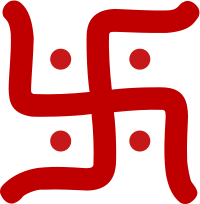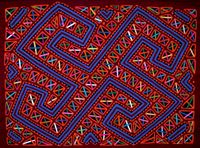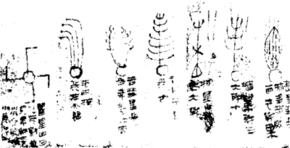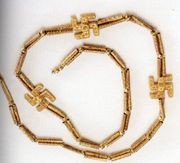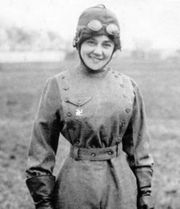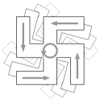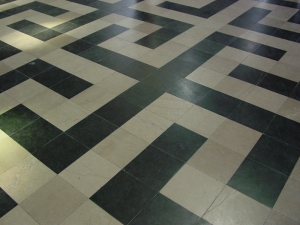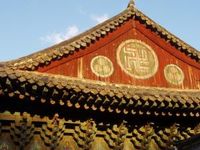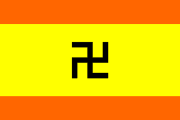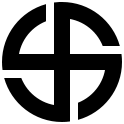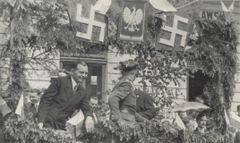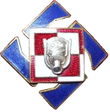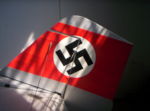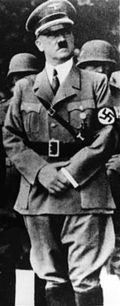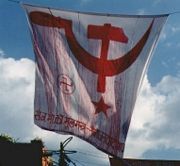Swastika
2007 Schools Wikipedia Selection. Related subjects: Religious disputes
The swastika (from Sanskrit स्वस्ितक svastika, from su "well", and asti "being", thus "good fortune" or "well-being") is an equilateral cross with its arms bent at right angles in either left-facing (卍) or right-facing (卐) direction. The swastika is a sacred symbol in Hinduism, Buddhism, Jainism and Odinism. The Hindu version is often decorated with a dot in each quadrant.
However, in the Western world, it is most widely known and used as a symbol of Nazism (the Hakenkreuz, "hook-cross") and this political association has eclipsed its historical status as the fylfot.
It is traditionally oriented so that a main line is horizontal, though it is occasionally rotated at forty-five degrees.
Overview
The Swastika has an extensive history. The motif seems to have first been used in Neolithic Eurasia. The swastika is used in religious and civil ceremonies in India. Most Indian temples, entrance of houses, weddings, festivals and celebrations are decorated with swastikas. The symbol was introduced to Southeast Asia by Hindu kings and remains an integral part of Balinese Hinduism to this day, and it is a common sight in Indonesia. The symbol has an ancient history in Europe, appearing on artifacts from pre-Christian European cultures. It was also adopted independently by several Native American cultures.
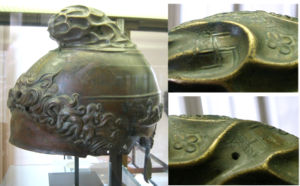
In the Western world, the symbol experienced a resurgence following the archaeological work in the late nineteenth century of Heinrich Schliemann, who discovered the symbol in the site of ancient Troy and associated it with the ancient migrations of Proto-Indo-Europeans. He connected it with similar shapes found on ancient pots in Germany, and theorised that the swastika was a "significant religious symbol of our remote ancestors," linking Germanic, Greek and Indo-Iranian cultures. By the early 20th century it was widely used worldwide and was regarded as a symbol of good luck and auspiciousness.
The work of Schliemann soon became intertwined with the völkisch movements, for which the swastika was a symbol of "Aryan" identity, a concept that came to be equated by theorists like Alfred Rosenberg with a Nordic master race originating in northern Europe. Since its adoption by the Nazi Party of Adolf Hitler, the swastika has been associated with fascism, racism ( white supremacy), World War II, and the Holocaust in much of the West. The swastika remains a core symbol of Neo-Nazi groups, and is also regularly used by activist groups to signify the supposed Nazi-like behaviour of organizations and individuals they oppose.
Etymology and alternative names
The word swastika is derived from the Sanskrit svastika (in Devanagari, स्वस्तिक), meaning any lucky or auspicious object, and in particular a mark made on persons and things to denote good luck. It is composed of su- (cognate with Greek ευ-, "eu-"), meaning "good, well" and asti a verbal abstract to the root as "to be"; svasti thus means "well-being". The suffix -ka forms a diminutive, and svastika might thus (andre) be translated literally as "little thing associated with well-being", corresponding roughly to "lucky charm", or "thing that is auspicious". The suffix -tika also literally means mark; therefore a sometimes alternate name for swastika in India is shubhtika (literally good mark). The word first appears in the Classical Sanskrit (in the Ramayana and Mahabharata epics).
Alternative historical English spellings of the Sanskrit word include suastika and svastica. Alternative names for the shape are:
- Black Spider, to various peoples in middle and western Europe
- crooked cross
- cross cramponned, ~nnée, or ~nny (in heraldry), as each arm resembles a crampon or angle-iron. (Compare Winkelmaßkreuz in German)
- cross gammadion, tetragammadion or just gammadion, as each arm resembles the Greek letter Γ ( gamma). (Compare crux gammata in Latin, croiz gammée in Old French and croix gammée in French; cruz gamada or esvástica in Spanish)
- double cross, by Bishop Fulton J. Sheen, on the April 6, 1941 edition of his radio program The Catholic Hour, not only comparing the Cross of Christ with the swastika, but also implying that siding with fascism was a " double-crossing" of Christianity.
- fylfot (possibly meaning "four feet", chiefly in heraldry and architecture). (See Fylfot for a discussion of the etymology)
- hooked cross (Dutch: hakenkruis; Serbian: kukasti krst; Icelandic: hakakross; German: Hakenkreuz; Finnish: hakaristi; Estonian: haakrist; Greek: αγκυλωτός σταυρός, agkylotos stavros; Norwegian: hakekors; Italian: croce uncinata; Romanian: Cruce încârligată; Swedish: hakkors; Danish: hagekors; Hungarian: horogkereszt; Czech: hákový kříž); Slovak: hákový kríž; Turkish: gamalı haç)
- sun wheel (German Sonnenrad), (Greek ηλιοτροχός, iliotrochos), a name also used as a synonym for the sun cross
- tetraskelion, Greek "four legged", especially when composed of four conjoined legs (compare triskelion)
- Thor's hammer, from its supposed association with Thor, the Norse god of the weather, but this may be a misappropriation of a name that properly belongs to a Y-shaped or T-shaped symbol. (See Thomas Wilson, below.) The Swastika shape appears in Icelandic grimoires wherein it is named Þórshamar.
- thunder cross ( Latvian: perkonkrusts)
- twisted cross
- unexpected cross ( Polish krzyżyk niespodziany) or highlander cross ( Polish góralski krzyż), swarge, swarzyca,Swastika comes from Old Indian boatman who saw the ple star Dhruv, Swastik was created to show boatman a sense of direciton
Test
History
In antiquity, the swastika was used extensively by the Indo-Aryans, Hittites, Celts and Greeks, among others. In particular, the swastika is a sacred symbol in Hinduism, Buddhism and Jainism. It occurs in other Asian, European, African and Native American cultures – sometimes as a geometrical motif, sometimes as a religious symbol.
Origin hypotheses
The ubiquity of the swastika symbol is easily explained by it being a very simple symbol that will arise independently in any basketweaving society. The swastika is a repeating design, created by the edges of the reeds in a square basket-weave. Other theories attempt to establish a connection via cultural diffusion or an explanation along the lines of Carl Jung's collective unconscious.
While the existence of the swastika symbol in the Americas may be explained by the basket-weave theory, its American presence weakens the cultural diffusion theory. While some have proposed that the swastika was secretly transferred to North America by an early seafaring civilization on Eurasia, a separate but parallel development is considered the most likely explanation.
Yet another explanation is suggested by Carl Sagan in his book Comet. Sagan reproduces an ancient Chinese manuscript that shows comet tail varieties: most are variations on simple comet tails, but the last shows the comet nucleus with four bent arms extending from it, recalling a swastika. Sagan suggests that in antiquity a comet could have approached so close to Earth that the jets of gas streaming from it, bent by the comet's rotation, became visible, leading to the adoption of the swastika as a symbol across the world.
Bob Kobres in Comets and the Bronze Age Collapse (1992) contends that the swastika-like comet on the Han Dynasty silk comet atlas was labeled a "long tailed pheasant star" due to its resemblance to a bird's foot., and further suggests that many swastika and swastika-like motifs may have been representations of bird tracks, including many of those found by Schliemann.
Barbara G. Walker, author of The Woman's Dictionary of Symbols and Sacred Objects, claims that the crux dissimulata, an early swastika, represented the four winds. Concerning the short-armed version of this symbol, known as the gammadion because it is made up of four Greek gammas, Walker says this symbol was an emblem of the ancient goddess and probably represented "the solstices and equinoxes, or the four directions, four elements, and four divine guardians of the world."

Archaeological record
The earliest swastika symbols of the archaeological record date to the Neolithic. The symbol was found on a number of shards in the Khuzestan province of Iran and as part of the " Vinca script" of Neolithic Europe of the 5th millennium BC. In the Early Bronze Age, it appears as part of the Indus script and on pottery found in Sintashta.
Swastika-like symbols also appear in Bronze and Iron Age designs of the northern Caucasus ( Koban culture), and Azerbaijan, as well as of Scythians and Sarmatians . In all these cultures the swastika symbol does not appear to occupy any marked position or significance, but appears as just one form of a series of similar symbols of varying complexity.
Historical use
In Zoroastrian Persia, the swastika symbolized the revolving sun (Garduneh-e Khorshid), Mithra's Wheel (Garduneh-e Mehr), fire, infinity, or continuing recreation. There is no reference to the swastika in the Vedas, the term svastika first appearing in Epic Sanskrit, but the symbol rose to importance in Hinduism and Buddhism in Maurya and Gupta India.
The use of the swastika by the indigenous Bön faith of Tibet, as well as syncretic religions, such as Cao Dai of Vietnam and Falun Gong of China, is thought to be borrowed from Buddhism as well. Similarly, the existence of the swastika as a solar symbol among the Akan civilization of southwest Africa may have been the result of cultural transfer along the African slave routes around AD 1500.
Adoption of the swastika in the West
The discovery of the Indo-European language group in the 1790s led to a great effort by archaeologists to link the pre-history of European peoples to the ancient " Aryans" (variously referring to the Indo-Iranians or the Proto-Indo-Europeans). Following his discovery of objects bearing the swastika in the ruins of Troy, Heinrich Schliemann consulted two leading Sanskrit scholars of the day, Emile Burnouf and Max Müller. Schliemann concluded that the Swastika was a specifically Indo-European symbol. Later discoveries of the motif among the remains of the Hittites and of ancient Iran seemed to confirm this theory. This idea was taken up by many other writers, and the swastika quickly became popular in the West, appearing in many designs from the 1880s to the 1920s.
These discoveries, and the new popularity of the swastika symbol, led to a widespread desire to ascribe symbolic significance to every example of the motif. In Germanic countries examples of similar shapes in ancient European artifacts and in folk art were interpreted as emblems of good-luck linked to the Indo-Iranian meaning.
Western use of the motif, along with the religious and cultural meanings attached to it, was subverted in the early twentieth century after it was adopted as the emblem of the Nazi Party (German: Nationalsozialistische Deutsche Arbeiterpartei). This association occurred because Nazism stated that the historical Aryans were the forefathers of modern Germans and then proposed that, because of this, the subjugation of the world by Germany was desirable, and even predestined. The swastika was used as a conveniently geometrical and eye-catching symbol to emphasize the so-called Aryan-German correspondence and instill racial pride. Since World War II, most Westerners know the swastika as solely a Nazi symbol, leading to incorrect assumptions about its pre-Nazi use in the West and confusion about its sacred religious and historical status in other cultures.
Geometry and symbolism
Geometrically, the swastika can be regarded as an irregular icosagon or 20-sided polygon. The arms are of varying width and are often rectilinear (but need not be). However, the proportions of the Nazi swastika were fixed: they were based on a 5x5 grid.
Characteristic is the 90° rotational symmetry (that is, the symmetry of the cyclic group C4h) and chirality, hence the absence of reflectional symmetry, and the existence of two versions which are each other's mirror image.
The mirror-image forms are often described as:
- left-facing and, as depicted across, right-facing;
- left-hand and right-hand;
- clockwise and counterclockwise.
"Left-facing" and "right-facing" are used mostly consistently. Looking at an upright swastika, the upper arm clearly faces towards the viewer's left (卍) or right (卐). The other two descriptions are ambiguous as it is unclear if they refer to the direction of the bend in each arm or to the implied rotation of the symbol. If the latter, whether the arms lead or trail remains unclear. The terms are used inconsistently (sometimes even by the same writer) which is confusing and may obfuscate an important point, that the rotation of the swastika may have symbolic relevance.
The interpretation of rotational direction may be influenced by the viewer's own bias. Critics of the swastika may see a right-facing design as an active, even aggressive symbol, slicing like a circular saw in a clockwise manner. A viewer with a more positive bias may consider the right-facing arms to be a passive design, rotating like a waterwheel in the opposite direction.
Nazi ensigns had a through and through image, so each version was present on one side, but the Nazi flag on land was right-facing on both sides ( , at the bottom).
The swastika is, after the simple equilateral cross (the " Greek cross"), the next most commonly found version of the cross.
Seen as a cross, the four lines emanating from the centre point to the four cardinal directions. The most common association is with the Sun. Other proposed correspondences are to the visible rotation of the night sky in the Northern Hemisphere around Polaris.
Sauwastika
The name sauwastika is sometimes given for the supposedly "evil", left-facing, form of the swastika (卍). A common belief is that the left-facing swastika is generally regarded as evil in Hindu tradition. This is because the much more common form in India is the right-facing swastika. Indians of all faiths sometimes use the symbol in both orientations - mostly for symmetry. Buddhists, outside of India, generally use the left-facing swastika over the right-facing swastika although, again, both can be used. Despite this, the misconception that the left-facing swastika is evil is widespread, even among some contemporary Indian communities.
Some contemporary writers — Servando González, for example — confuse matters even further by asserting that the right-facing swastika, used by the Nazis is in fact the "evil" sauwastika. (González "proves" that the left-facing swastika is the sunwise one with reference to a 1930s box of Standard fireworks from Sivakasi, India.) This inversion – whether intentional or not – might derive from a desire to prove that the Nazis' use of the right-handed swastika was expressive of their "evil" intent. (See also Taboo in Western countries.) But the notion that Adolf Hitler deliberately inverted the "good left-facing" swastika is wholly unsupported by any historical evidence.
Art and architecture
The swastika is common as a design motif in current Hindu architecture and Indian artwork as well as in ancient Western architecture, frequently appearing in mosaics, friezes, and other works across the ancient world. Ancient Greek architectural designs are replete with interlinking swastika motifs. Related symbols in classical Western architecture include the cross, the three-legged triskele or triskelion and the rounded lauburu. The swastika symbol is also known in these contexts by a number of names, especially gammadion.
In Chinese, Korean, and Japanese art, the swastika is often found as part of a repeating pattern. One common pattern, called sayagata in Japanese, comprises left and right facing swastikas joined by lines. As the negative space between the lines has a distinctive shape, the sayagata pattern is sometimes called the "key fret" motif in English.
The swastika symbol was found extensively in the ruins of the ancient city of Troy and can also be found in some of the mosaics in the ruins of Pompeii.
In Greco-Roman art and architecture, and in Romanesque and Gothic art in the West, isolated swastikas are relatively rare, and the swastika is more commonly found as a repeated element in a border or tessellation. The swastika often represented perpetual motion, reflecting the design of a rotating windmill or watermill. A design of interlocking swastikas is one of several tessellations on the floor of the cathedral of Amiens, France. A border of linked swastikas was a common Roman architectural motif, and can be seen in more recent buildings as a neoclassical element. A swastika border is one form of meander, and the individual swastikas in such border are sometimes called Greek keys.
The Laguna Bridge in Yuma, Arizona was built in 1905 by the U.S. Reclamation Department and is decorated with a row of swastikas.
Metal typeface Swastika borders were used by U.S. printers in the early 1900's. Controversy arose in 1937 when they appeared on Passaic, New Jersey sample election ballots. The printer responded "I've used the swastika emblems for ballot borders long before the world ever knew Hitler".
The Canadian artist ManWoman has attempted to rehabilitate the " gentle swastika".
Swastika Tiles
Ceramic tiles with a swastika design have appeared in many parts of the world including the United States in the early part of the 20th century. When originally installed, the tiles are typically a minor decorative element. The durable tiles have been a source of controversy when they are assumed to be Nazi symbols.
Swastika tiles adorn the New Jersey Statehouse in Trenton, built in the 1930's. A newspaper article in The Press of Atlantic City notes that the statehouse tiles were created by the local Mueller Tile Mosaic Company, using an innovative technique that combined glazing and deep carving to create a photographic-like sense of depth. The tiles were installed throughout the US and Canada.
Reprints of tile catalogs, including the 1930 Mueller Tile Faience Inserts catalogue are available from the non-profit California based Tile Heritage Foundation's website. At least two other US tile manufacturers also produced swastika tiles among their many designs. The Tile Heritage Foundation website features sample pages from more than 90 tile catalogs, including two that include swastika designs. The 1920 Wheatley Pottery Company of Cincinnati Ohio, and the 1928 catalog from the Cambridge-Wheatley Company of Covington, Kentucky, which marketed Wheatley tiles.
- The Mueller tiles with swastika design can be found at the St. James Episcopal Church (1927), and the Immanuel Presbyterian Church (1928) in Los Angeles.
- In May of 2006, five terra cotta tiles were removed from St. Mary's Cathedral in St. Cloud Minnesota, the oldest parish in the community. The upper church, constructed in the late 1920's, included a number of decorative tiles including a series of ten that depicted ancient forms of the cross. Located near the eaves, the tiles represented the crux gammata, also known as the Gammadion, "hooked cross". The swastika tiles alternated with a related design featuring the Lauburu or "Basque cross". The building was designed in the Italian Romanesque style by a local architect who added Art Deco features, including the ancient symbols, sunburst brick patterns and zig zag details.
- Three of the tiles were destroyed in the process of removal, one was put on permanent display at the church. The removal was prompted in part by criticism from some current and former faculty at St. Cloud State University, where the university's electronic diversity newsletter featured a series of articles, including a history of the swastika that claimed by 1920 it was already "the symbol of Aryan conquest and mastery". At the time of construction, the church was under the control of the Benedictine Monks at St. Johns University in Collegeville, who arrived in Central Minnesota in 1851 from Pennsylvania.
- According to documents at the Stearns History Museum in St. Cloud, approximately ten years before St. Mary's was designed, there were more than 2000 local residents from the heavily German Catholic area serving in the US military, fighting against Germany. President Wilson wrote a letter to the local Catholic bishop thanking him for his support of the war effort
- The removal coincided with the sesquicentennial anniversary for the city, St. John's University and St. Mary's parish.
- Other Catholic Cathedrals that include swastika tiles among their decorations include: Saint Joseph Cathedral, Wheeling, West Virginia, a Romanesque design by architect Edward J. Weber of Pittsburgh, completed in 1925. St. Colman's Cathedral, built between 1868 and 1925 overlooking the port city of Cobh Ireland. Christ Church Cathedral, New Zealand, constructed in the 1880's. The Cathedral of Tampico, Mexico, completed in the late 19th century with additional remodeling (see Tour By Mexico website for photograph of swastika tile floor, click on fifth camera icon).
- In November 1998 the Rome, New York Sentinel newspaper reported that swastika tiles were removed from the Gansevoort Elementary School where they had survived on a school floor for 84 years. The newspaper's editorial responded: "School officials lost a chance to enlighten the public. A recommendation earlier this year by a committee of Gansevoort staff and parents to "leave the floor as is" and install a display about the history of the swastika was ignored. Instead, at the risk of being viewed by a small, uninformed segment of the community as being politically incorrect, they knuckled under to pressure rather than educate. How unfortunate!"
- The same Sentinel editorial also notes that similar tiles were left untouched at a Jewish synagogue, Temple Beth El, in nearby Utica, New York "because the connotation to the Jewish congregation is not that of the Third Reich."
- The Reuters News Agency reported in 1990 that the seaside community of Hull, Massachusetts voted to remove swastika tiles from their town hall floor, built in 1923, after complaints from the New England Director of the Jewish Defense League. The removal went forward in spite of opposition from a local Jewish synagogue. The chairman of the JDL at the time was arrested 11 years later by the Federal Bureau of Investigation in a plot to bomb a California mosque and local office for a U.S. Congressman. The FBI described the JDL as a "violent extremist" organization. The moderate Anti-Defamation League applauded the FBI arrests.
- The World Jewish Briefing reported in 2004 that Bonneville County Commissioners in Idaho Falls ordered swastika tiles removed from a courthouse floor that was built in 1921. The building is listed on the National Register of Historic Places.
- Swastika tiles are visible at the San Diego Mission Beach Plunge swimming pool, which opened in 1925.
- The Orcutt ranch in Canoga Park, California, completed about 1926, is decorated with Native American swastikas. The property has been designated a Los Angeles Historic-Cultural Monument.
- A swastika design is visible on the exterior of the Detroit, Michigan downtown public library, built in 1931. A local website notes "They were a popular item in certain Deco designs, and many are used in architecture throughout Downtown Detroit. They also can be seen quite often on floor tiles in church buildings."
- The Plays and Players Theatre, built in 1912 in Philadelphia, Pennsylvania, has colored swastika floor tiles. The theatre was added to the National Register of Historic Places in 1973.
- A New York City Subway station at Columbia University featured a 1904 ceramic mosaic design with a border of swastikas.
- A bank in Bolton England has refused to remove swastika mosaic tiles from the entry of a branch office constructed in 1927. A bank spokesperson replied to critics noting that "At that time, these symbols were commonly used as architectural decoration."
- The Anti-Defamation League Law Enforcement Resource Network describes the swastika in its visual database of extremist symbols, with only a vague reference to its use by religious groups, but specifics about left and right facing symbols.
- "When shown in a counterclockwise direction, an ancient religious symbol that represented a sign of good luck."
- "Prior to the Nazis co-opting this symbol, it was known as a good luck symbol and was used by various religious groups. Hitler made the Nazi swastika unique to his party by reversing the normal direction of the symbol so that it appeared to spin clockwise."
- Using the definition the ADL has provided to law enforcement agencies, most of the historic tiles listed above could be classified as extremist symbols because their arms are not in what the ADL calls the "normal" orientation.
- "Prior to the Nazis co-opting this symbol, it was known as a good luck symbol and was used by various religious groups. Hitler made the Nazi swastika unique to his party by reversing the normal direction of the symbol so that it appeared to spin clockwise."
Religion and mythology
Hinduism
In Hinduism, the two symbols represent the two forms of the creator god Brahma: facing right it represents the evolution of the universe (Pravritti), facing left it represents the involution of the universe (Nivritti). It is also seen as pointing in all four directions (North, East, South and West) and thus signifies stability and groundedness. Its use as a sun symbol can first be seen in its representation of the god Surya. The swastika is considered extremely holy and auspicious by all Hindus, and is regularly used to decorate all sorts of items to do with Hindu culture. It is used in all Hindu yantras and religious designs. Throughout the subcontinent of India it can be seen on the sides of temples, written on religious scriptures, on gift items, and on letterhead. The Hindu god Ganesh is often shown as sitting on a lotus flower on a bed of swastikas.
The swastika is found all over Hindu temples, signs, altars, pictures and iconography where it is sacred. It is used in all Hindu weddings, festivals, ceremonies, houses and doorways, clothing and jewelry, motor transport and even decorations on food items like cakes and pastries. Amongst the Hindus of Bengal, it is common to see the name "swastika" applied to a slightly different symbol, which has the same significance as the common swastika, and both symbols are used as auspicious signs. This symbol looks something like a stick figure of a human being. "Swastika" is a common given name amongst Bengalis and a prominent literary magazine in Calcutta is called the Swastika. The stick figure, however, is not mainstream usage in India.
The Aum symbol is also sacred in Hinduism. While Aum is representative of a single primordial tone of creation, the Swastika is a pure geometrical mark and has no syllabic tone associated with it. The Swastika is one of the 108 symbols of Lord Vishnu and represents the sun's rays without which there would be no life.
Buddhism
Buddhism originated in the Indian subcontinent in the 5th century BCE and inherited the swastika. These two symbols are included, at least since the Liao Dynasty, as part of the Chinese language, the symbolic sign for the character 萬 or 万 (wàn in Chinese, man in Korean/Japanese, vạn in Vietnamese) meaning "all", and "eternality" (lit. myriad) and as 卐 which is seldom used. A swastika marks the beginning of many Buddhist scriptures. The swastikas (in either orientation) appear on the chest of some statues of Gautama Buddha and is often incised on the soles of the feet of the Buddha in statuary. Because of the association with the right facing swastika with Nazism, Buddhist swastikas (outside India only) after the mid-20th century are almost universally left-facing: 卍. This form of the swastika is often found on Chinese food packaging to signify that the product is vegetarian and can be consumed by strict Buddhists. It is often sewn into the collars of Chinese children's clothing to protect them from evil spirits.
In 1922, the Chinese syncretist movement Daoyuan founded the philanthropic association Red Swastika Society in imitation of the Red Cross. The association was very active in China during the 1920s and the 1930s.

The swastika used in Buddhist art and scripture is known in Japanese as a manji (which literally just means "the Chinese character for eternality" 万字), and represents Dharma, universal harmony, and the balance of opposites. When facing left, it is the omote (front) manji, representing love and mercy. Facing right, it represents strength and intelligence, and is called the ura (rear) manji. Balanced manji are often found at the beginning and end of Buddhist scriptures (outside India).
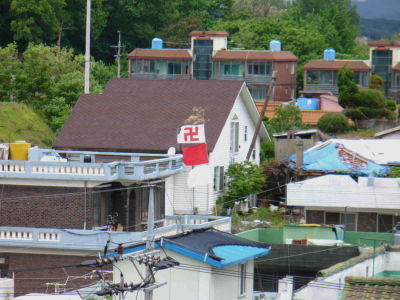
Jainism
Jainism gives even more prominence to the swastika than Hinduism. It is a symbol of the seventh Jina (Saint), the Tirthankara Suparsva. It is considered to be one of the 24 auspicious marks and the emblem of the seventh arhat of the present age. All Jain temples and holy books must contain the swastika and ceremonies typically begin and end with creating a swastika mark several times with rice around the altar. Jains use rice to make a swastika (also known as "Sathiyo" in the state of Gujarat, India) in front of idols in a temple. Jains then put an offering on top of this swastika - this offering is usually a fruit, a sweet (mithai), a dried fruit or sometimes a coin or currency note.
Abrahamic religions
The swastika was not widely utilized by followers of the Abrahamic religions. Where it does exist, it is not portrayed as an explicitly religious symbol and is often purely decorative or, at most, a symbol of good luck. One example of scattered use is the floor of the synagogue at Ein Gedi, built during the Roman occupation of Judea, which was decorated with a swastika.
In Christianity, the swastika is sometimes translated as a symbol representing the resurrection of Jesus Christ (the swastika can be seen as a hooked crucifix, symbolizing Christ's victory over death.) Some Christian churches built in the Romanesque and Gothic eras are decorated with swastikas, carrying over earlier Roman designs. Swastikas are prominently displayed in a mosaic in the St. Sophia church of Kiev, Ukraine dating to the 12th century. They also appear as a repeating ornamental motif on a tomb in the Basilica of St. Ambrose in Milan. However, a proposed direct link between it and a swastika floor mosaic in the Cathedral of Our Lady of Amiens, which was built on top of a pagan site at Amiens, France in the 1200s, is considered unlikely.
The Muslim "Friday" mosque of Isfahan, Iran and the Taynal Mosque in Tripoli, Libya both have swastika motifs.
Other Asian traditions
Some sources indicate that the Chinese Empress Wu (武則天)(684-704) of the Tang Dynasty decreed that the swastika would be used as an alternative symbol of the sun. As part of the Chinese script, the swastika has Unicode encodings U+534D 卍 (pronunciation following the Chinese character "萬": Cantonese: "man"; Mandarin: wan); (left-facing) and U+5350 卐 (right-facing).
The Mandarin "Wan" is a homophone for "10,000" and is commonly used to represent the whole of creation, e.g. 'the myriad things' in the Dao De Jing.

In Japan, the swastika is called manji. Since the Middle Ages, it is used as a family coat of arms. On Japanese maps, a swastika (left-facing and horizontal) is used to mark the location of a Buddhist temple. The right-facing manji is often referred as the gyaku manji (逆卍, lit. "reverse manji"), and can also be called kagi jūji, literally "hook cross."
The left-facing Buddhist swastika also appears on the emblem of Falun Gong. This has generated considerable controversy, particularly in Germany, where the police have reportedly confiscated several banners featuring the emblem. A court ruling subsequently allowed Falun Gong followers in Germany to continue the use of the emblem.
Native American traditions
The swastika shape was used by some Native Americans. It has been found in excavations of Mississippian-era sites in the Ohio valley. It was widely used by many southwestern tribes, most notably the Navajo. Among different tribes the swastika carried various meanings. To the Hopi it represented the wandering Hopi clan; to the Navajo it was one symbol for a whirling winds (tsil no'oli'), a sacred image representing a legend that was used in healing rituals (after learning of the Nazi mimic "whirling winds" the Navajo rejected the symbol). A brightly colored Native American saddle featuring swastika designs is on display at a museum in Saskatchewan, Canada.
A swastika shape is an ancient symbol in the culture of the Kuna people of Kuna Yala, Panama. In Kuna tradition it symbolises the octopus, which created the world; its tentacles, pointing to the four cardinal points, gave rise to the rainbow, the sun, the moon and the stars.
In February, 1925, the Kuna revolted against Panamanian suppression of their culture, and were granted autonomy in 1930; the flag which they adopted at this time is based on the swastika shape, and remains the official flag of Kuna Yala. A number of variations on the flag have been used over the years; red top and bottom bands instead of orange were previously used, and in 1942 a ring (representing the traditional Kuna nose-ring) was added to the centre of the flag to distance it from the symbol of the Nazi party.
Pre-Christian European religions
The swastika (also called a fylfot, a term coined in the 19th century from a 1500 reference to a figure used to fill empty space at the foot of stained-glass windows in medieval churches) appears as an ornament on many pre-Christian artefacts, drawn both left-facing and right-facing. Similar motifs, within a circle or in a swirling form have also been interpreted as "swastikas".
The Greek goddess Athena was sometimes portrayed as wearing robes covered with swastikas.
An Ogham stone found in Anglish, Co Kerry ( CIIC 141) was modified into an early Christian gravestone, and was decorated with a cross pattée and two swastikas at this time. The pre-Christian Anglo-Saxon ship burial at Sutton Hoo, England, contains gold cups and shields adorned with swastika-like shapes.
The pre-Christian Norse regularly used the so-called Sun cross or Sun wheel one form of which is often interpreted as a variant of the swastika, and it appears regularly in Scandinavian folk art. Swastika shapes are found, among similar ornaments, on Germanic Migration period artifacts, such as the Gothic spearhead found at Brest-Litovsk, Russia, or the Younger Futhark Snoldelev Stone, in Ramsø, Denmark.
In some Neopagan religions, such as Asatru and Heathenry these swastika-like shapes are often used as religious symbols. Adherents of these faiths note that their use is not connected to the political implications that the symbol gained under Nazism, citing the pre-Christian Germanic use of the symbol.
The swastika shape was also present in pre-Christian Slavic mythology. It was dedicated to the sun god Svarog and called kolovrat, ( Polish kolowrót). In the Polish first Republic the symbol of the swastika was also popular with the nobility. According to chronicles, Varangians prince Oleg who in the 9th century with his Rus Vikings had captured Constantinople, had nailed his shield to the city's gates, which had a large red swastika painted on it. The several Polish noble houses, e.g. Boreyko, Borzym, and Radziechowski from Ruthenia also had Swastikas as their coat of arms. The family had reached its greatness in the 14-15th centuries and their crest can be seen in many heraldry books produced at that time.
The Vatican Museums contain examples of Etruscan pottery bearing the swastika.
Medieval Vehmic courts
Walker (A Woman's Dictionary of Symbols and Sacred Objects) states that the double swastika was associated with the Vehmic courts of the Middle Ages, a " secret sect" founded to persecute " heretics and Jews" before becoming associated with the Inquisition. These courts, she says, continued as "underground societies of summary justice" and "hotbeds of anti-Semitism" during the nineteenth century before being superseded by the Nazi party, the members of which substituted the single swastika for the doubled version.
Early 20th century
United Kingdom
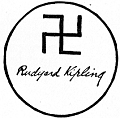
The pre-Christian Anglo-Saxon ship burial at Sutton Hoo, England, contains gold cups and shields adorned with swastika-like shapes.
The British author Rudyard Kipling, who was strongly influenced by Indian culture, had a swastika as his personal moniker on the dust jackets of all his books until the rise of Nazism made this inappropriate. One of Kipling's Just So Stories, "The Crab That Played With The Sea", had an elaborate full-page illustration by Kipling including a stone bearing what was called "a magic mark" (a swastika); some later editions of the stories blotted out the mark, but not its captioned reference, making the readers wonder what the "mark" was.
During World War I, the swastika was used as the emblem of the British National War Savings Committee. Image
The swastika was also used as a symbol by the Boy Scouts in the United Kingdom, and worldwide. According to "Johnny" Walker, the earliest Scouting use was on the first Thanks Badge introduced in 1911. Robert Baden-Powell's 1922 Medal of Merit design adds a swastika to the Scout fleur-de-lis as good luck to the person receiving the medal. Like Kipling, he would have come across this symbol in India. During 1934 many Scouters requested a change of design because of the use of the swastika by the Nazis. A new British Medal of Merit was issued in 1935.
Finland
In Finland the swastika was used as the official national marking of the Army between 1918 and 1st April, 1945, and also of the Finnish Air Force, anti-aircraft troops as a part of the air force and tank troops at that time. The swastika was also used by the Lotta Svärd organisation. The blue swastika was the good luck symbol used by the family of Swedish Count Eric von Rosen, who donated the first plane to the Finnish White Army during the Finnish Civil War. It has no official connection to the Nazi use of the swastika but represents the Cross of Freedom, the oldest order in Finland. This, however, remains for some people controversial, because Rosen was later one of the founding members of Nationalsocialistiska Blocket, a Swedish Nazi political party. Rosen also gained a closer connection to Germany when Hermann Göring married Carin von Kantzow, whose sister was married to Rosen.
The national socialistic party of Germany, adopted the swastika as its party symbol two years later, 1920.
The swastika also appeared in Finnish medals and decorations. The decorations of the Order of the Cross of Liberty, mostly designed by Akseli Gallen-Kallela in 1918, bears a Swastike laid on a George's Cross. As the Grand Master of the order, the President of Finland uses a Cross of Liberty in her personal flag.
Iceland
The Icelandic Steamship Company, Eimskip (founded in 1914) used a swastika in its logo.
Ireland
An Ogham stone found in Anglish, Co Kerry ( CIIC 141) was modified into an early Christian gravestone, and was decorated with a cross pattée and two swastikas at this time.
The " Ogham stone" found in County Kerry, Ireland is inscribed with several swastikas dating to the fifth century AD, and is believed to have been an altar stone of the Druids.
In Dublin, Ireland, a laundry company known as the Swastika Laundry existed for many years in Ballsbridge on the south side of the city. Upon the outbreak of the Second World War in 1939, the company's customers were concerned abou the company's name. Accordingly, it changed it to "Swastika Laundry (1912) Ltd". The company's fleet of electric delivery vans were red, and featured a black swastika on a white background. The business started in the early 20th century and continued up until recent times. The Laundry's tall chimneystack was emblazoned with a large white Swastika, which was clearly visible from the surrounding streets. The name and logo eventually disappeared when the laundry was absorbed into the Spring Grove company.
In his "Irisches Tagebuch" the future Nobel Laureate, Heinrich Böll writes about a year spent living in the west of Ireland in the 1950s. While in Dublin before heading to Co. Mayo, he…
"was almost run over by a bright-red panel truck whose sole decoration was a big swastika. Had someone sold Völkischer Beobachter delivery trucks here, or did the Völkischer Beobachter still have a branch office here? This one looked exactly like those I remembered; but the driver crossed himself as he smilingly signalled to me to proceed, and on closer inspection I saw what had happened. It was simply the "Swastika Laundry," which had painted the year of its founding, 1912, clearly beneath the swastika; but the mere possibility that it might have been one of those others was enough to take my breath away."
One story tells how the physicist Erwin Schrödinger, in political exile in Ireland after fleeing the Nazi regime, was almost killed by one of these vans when crossing the street, and briefly believed an attempt had been made on his life by the Third Reich.
Latvia
In Latvia, too, the swastika (known as Thunder Cross and Fire Cross) was used as the marking of the Latvian Air Force between 1918 and 1934, as well as in insignias of some military units. It was also used by the Latvian fascist movement Perkonkrusts (Thunder Cross in Latvian), as well as by other non-political organizations. Latvian left facing swastika or Thunder Cross dates back to Bronze age. It is widely seen scratched on the surfaces like rocks, weapons and pottery as a protector sign. To avoid diplomatic embarrassment, Latvian officials were asked by NATO not to put swastikas on mittens and other gifts to delegates at a summit in the country in 2006.
North America
The Theosophical Society, founded in New York in 1875, incorporated the Swastika into its seal because of the Hindu and Buddhist associations of the symbol, combining it with a Star of David, Ankh and Ouroboros.
The swastika's use by the Navajo and other tribes made it a popular symbol for the Southwestern United States. Until the 1930s, blankets, metalwork, and other Southwestern souvenirs were often made with swastikas.
- Arizona state highway markers up until 1940 featured a right-facing swastika superimposed on an arrowhead ( Arizona Roads)
- The KiMo Theatre in Albuquerque, New Mexico, built in 1927 in the Pueblo Deco style and restored in 2000, is owned and operated by the city, which describes it as an "architectural gem". The building includes Native American design elements, including swastikas.. It was nearly torn down in 1977, the same year the KiMo was listed on the National Register of Historic Places.
- A hand-carved wooden horse with swastikas on its saddle has been removed from a classic carousel at a shopping centre in Portland, Oregon following complaints by the public. The carousel was built in Kansas for the 1904 St. Louis World's Fair and was a featured ride at Jantzen Beach Amusement Park which opened in 1928 as the largest amusement park in the US. The Parker "Four-Row Park Carousel" was added to the National Register of Historic Places in 1987.
- In 1907, the Corn Palace in Mitchell, South Dakota, featured a design that had a swastika on one of the towers.
- In Rapid City, South Dakota, there are swastikas in the lobby of the Hotel Alex Johnson, which opened in 1928. They are decorations honoring the Native American culture of Western South Dakota. The hotel is listed on the National Register of Historic Places.
- The original 1936 patented design (no. 98,617) for the Wigwam Motel called for four swastikas to encircle each tipi shaped motel room.
- Swastika is the name of a small community in northern Ontario, Canada, approximately 580 kilometres north of Toronto, and 5 kilometres west of Kirkland Lake, the town of which it is now part. The town of Swastika was founded in 1906. Gold was discovered nearby and the Swastika Mining Company was formed in 1908. The government of Ontario attempted to change the town's name during World War II, but the town resisted.
- The Swastika United Church is located in Swastika, Ontario.
- The foyer of Central High School in Pueblo, Colorado features right-facing swastikas set into the tile floor. The school was built in 1906.
- In Windsor, Nova Scotia, there was an ice hockey team from 1905 to 1916 named the Swastikas, and their uniforms featured swastika symbols. There were also hockey teams named the Swastikas in Edmonton, Alberta (circa 1916), and Fernie, British Columbia (circa 1922).
- At least one minor league baseball team used the name: the Canon City Swastikas represented Canon City, Colorado in the Class D Rocky Mountain League in 1912. The team moved to Raton, New Mexico mid-season, then disbanded along with the league.
- The 45th Infantry Division of the United States Army used a yellow swastika on a red background as a unit symbol until the 1930s, when it was switched to a thunderbird.~
- In 1925, Coca-Cola made a lucky watch fob in the shape of a swastika with the slogan, "Drink Coca Cola five cents in bottles".
- The Health, Physical Education and Recreation Building (HPER) at Indiana University contains decorative Native American-inspired reverse swastika tilework on the walls of the foyer and stairwells on the southeast side of the building. HPER was built as the university fieldhouse in the 1920s, before the Nazi party came to power in Germany. In recent years, the HPER swastika motif, along with the Thomas Hart Benton murals in nearby Woodburn Hall have been the cause of much controversy on campus.
- The public access area of Fish Lake near Windom, Minnesota is named Swastika Beach.
- The U.S. Navy base at Coronado, California has buildings laid out in a swastika shape.
- Shortly after the beginning of World War II, several Native American tribes (the Navajo, Apache, Tohono O'odham, and Hopi) published a decree stating that they would no longer use the swastika in their artwork. This was because the swastika had come to symbolize evil to them. This decree was signed by representatives of these tribes. The decree states:
- Because the above ornament which has been a symbol of friendship among our forefathers for many centuries has been desecrated recently by another nation of peoples.
- Therefore it is resolved that henceforth from this date on and forever more our tribes renounce the use of the emblem commonly known today as the swastika or fylfot on our blankets, baskets, art objects, sandpainting, and clothing.
- The New Mexico State University yearbook continued under the name "The Swastika" in honour of the traditional meaning of the symbol. The University has an archive of a 1983 campaign to change the name, including correspondence with the Anti-Defamation League.
- The "Swastika Series" is a name given to a soil type in New Mexico by the US National Cooperative Soil Survey.
- Flour was sold under the brand name Swastika by the Monte Vista Milling and Elevator Company of Colorado, which registered the name in 1910.
- The Augustan Society Headquarters and Library, built in 1916 in the Mojave Desert in Daggett, California, includes Native American swastika designs. The non-profit is "An International Genealogical, Historical Heraldic and Chivalric Society".
- The restored Balboa Park Hospitality House in San Diego, California became controversial when swastika symbols were discovered on five light fixtures. The design dates to 1935. Park officials welded metal plates over the swastikas after a protest by the Anti-Defamation League.
- A 2004 CBS television special on US mass murderer Charles Manson inaccurately portrayed Manson's forehead tattoo. "The hooks of the Hakenkreuz (or hooked cross of the Swastika) are removed leaving what amounts to the logo for X Box."
- At the University of Maine, in Orono, Maine, the following dorms are shaped like swastikas: Somerset, Oxford, and Knox. Google map UMAINE map
- Jewish artist Edith Altman, whose family fled Germany in the late 1930's, has produced a traveling exhibit entitled Reclaiming the Symbol . "The work strives to reclaim the star, the cross and the swastika to their positive use.".
- The Bahá'í House of Worship for the North American continent, located in Wilmette, Illinois, depicts swastikas on each of its 9 outer pillars. The swastikas are interspersed with symbols traditionally associated with various world religions.
Argentina
Several columns at the train station of Retiro in Buenos Aires are decorated with joint swastikas. The Estación Retiro opened in 1915.
Poland
Since the early Middle Ages the sign of the swastika was well-established among all Slavic lands. Known as swarzyca, it was primarily associated with one of the Slavic gods named Svarog.
With time the significance of the symbol faded, but it was preserved in numerous cases as a personal symbol of various personalities, as was the case of the Boreyko Coat of Arms. It was also preserved in the folk culture of the region of Podhale, where it was used as a talisman well into the 20th century. As a solar symbol, it was painted or carved on various parts of houses in the Tatra Mountains and was thought to save the household from evil.
The ancient symbol used by the Góral societies was adopted by the Polish mountain infantry units in the 1920s. It was adopted as a regimental insignia by the artillery units of the 21st and 22nd Infantry Divisions, as well as by the soldiers of the 4th Legions' Infantry, the 2nd and the 4th Podhale Rifles. A distinctive blue swastika was a background emblem of The Air defence and Anti-gas League (1928-1939, LOPP), which had circa 1.5 million members in 1937.
Outside of the military traditions, the mountaineer's swastika also influenced a number of other symbols and logos used on Polish soil. Among such was the logo of the IGNIS publishing company (est. 1822), and the personal symbol of Mieczysław Karłowicz, a notable composer and admirer of the Tatras. After his tragic death in the mountains in 1909, the place of his death was marked by a memorial stone and a swastika . Finally, it was also used as a personal logo and ex libris by Walery Eliasz-Radzikowski of Boreyko Coat of Arms, a Polish author who was also strongly influenced by the Polish mountaineers and had a swastika on the dust jackets of all his books and letters.
Russia
The Russian Provisional Government of 1917 printed a number of new bank notes with right-facing, diagonally rotated swastikas in their centres.
Sweden
The Swedish company ASEA, now a part of Asea Brown Boveri, used the swastika in its logo from the 1890s to 1933, when it was removed from the logo.
Nazi Germany

Flag Ratio: 3:5
Flag Dimensions: 60 x 100
Disc Diameter: 45
Arm Width: 6
The Nazi Party (Nationalsozialistische Deutsche Arbeiterpartei or NSDAP) formally adopted the swastika or Hakenkreuz (hooked cross) in 1920. This was used on the party's flag (right), badge, and armband. It had also been used unofficially by the NSDAP and its predecessor, the German Workers Party, Deutsche Arbeiterpartei (DAP).
In Mein Kampf, Adolf Hitler wrote:
- "I myself, meanwhile, after innumerable attempts, had laid down a final form; a flag with a red background, a white disk, and a black swastika in the middle. After long trials I also found a definite proportion between the size of the flag and the size of the white disk, as well as the shape and thickness of the swastika."
(Red, white, and black were the colors of the flag of the old German Empire.)
The use of the swastika was associated by Nazi theorists with their conjecture of Aryan cultural descent of the German people. Following the Nordicist version of the Aryan invasion theory, the Nazis claimed that the early Aryans of India, from whose Vedic tradition the swastika sprang, were the prototypical white invaders. It was also widely believed that the Indian caste system had originated as a means to avoid racial mixing. The concept of Racial purity was an ideology central to Nazism though it is now considered unscientific. For Rosenberg, the Aryans of India were both a model to be imitated and a warning of the dangers of the spiritual and racial "confusion" that, he believed, arose from the close proximity of races.
Thus, they saw fit to co-opt the sign as a symbol of the Aryan master race. The use of the swastika as a symbol of the Aryan race dates back to writings of Emile Burnouf. Following many other writers, the German nationalist poet Guido von List believed it to be a uniquely Aryan symbol. When Hitler created a flag for the Nazi party, he sought to incorporate both the swastika and "those revered colors expressive of our homage to the glorious past and which once brought so much honour to the German nation" (red, white and black). He also stated that "the red expressed the social thought underlying the movement. White the national thought. And the swastika signified the mission allotted to us – the struggle for the victory of Aryan mankind and at the same time the triumph of the ideal of creative work which is in itself and always will be anti-Semitic." (Mein Kampf).
In fact, the swastika was already in use as a symbol of German völkisch nationalists movements ( Völkische Bewegung). In Deutschland Erwache ( ISBN 0-912138-69-6), Ulric of England (sic) says —
- … what inspired Hitler to use the swastika as a symbol for the NSDAP was its use by the Thule Society (Ger. Thule-Gesellschaft) since there were many connections between them and the DAP … from 1919 until the summer of 1921 Hitler used the special Nationalsozialistische library of Dr. Friedrich Krohn, a very active member of the Thule-Gesellschaft, … Dr. Krohn was also the dentist from Sternberg who was named by Hitler in Mein Kampf as the designer of a flag very similar to one that Hitler designed in 1920 … during the summer of 1920, the first party flag was shown at Lake Tegernsee … these home-made … early flags were not preserved, the Ortsgruppe München flag was generally regarded as the first flag of the Party.
José Manuel Erbez says —
- The first time the swastika was used with an "Aryan" meaning was on December 25, 1907, when the self-named Order of the New Templars, a secret society founded by [Adolf Joseph] Lanz von Liebenfels, hoisted at Werfenstein Castle (Austria) a yellow flag with a swastika and four fleurs-de-lys.
However, Liebenfels was drawing on an already established use of the symbol.
On 14 March 1933, shortly after Hitler's appointment as Chancellor of Germany, the NSDAP flag was hoisted alongside Germany's national colors. It was adopted as the sole national flag on 15 September 1935.
The swastika was used for badges and flags throughout Nazi Germany, particularly for government and military organizations, but also for "popular" organizations such as the Reichsbund Deutsche Jägerschaft.
While the DAP and the NSDAP had used both right-facing and left-facing swastikas, the right-facing swastika is used consistently from 1920 onwards. However, Ralf Stelter notes that the swastika flag used on land had a right-facing swastika on both sides, while the ensign (naval flag) had it printed through so that you would see a left-facing swastika when looking at the ensign with the flagpole to the right.
Several variants are found:
- a 45° black swastika on a white disc as in the NSDAP and national flags;
- a 45° black swastika on a white lozenge (e.g., Hitler Youth);
- a 45° black swastika with a white outline was painted on the tail of aircraft of the Luftwaffe;
- a 45° black swastika outlined by thin white and black lines on a white disc (e.g., the German War Ensign);
- an upright black swastika outlined by thin white and black lines on a white disc (e.g., Hitler's personal flag, in which a gold wreath encircles the swastika; the Schutzstaffel; and the Reichsdienstflagge, in which a black circle encircles the swastika);
- small gold, silver, black, or white 45° swastikas, often lying on or being held by an eagle, on many badges and flags.
- a swastika with curved outer arms forming a broken circle, as worn by the SS Nordland Division. (See photo at " Nordland Reenactors".)
There were attempts to amalgamate Nazi and Hindu use of the swastika. Notably by Savitri Devi Mukherji who declared Hitler an avatar of Vishnu (see Nazi mysticism).
Taboo in Western countries
Because of its use by Hitler and the Nazis and, in modern times, by neo-Nazis and other hate groups, for many people in the West, the swastika is associated primarily with Nazism, and white supremacy in general. Hence, outside historical contexts, it has become taboo in Western countries. The historical context of architectural decorations has sometimes been ignored in local efforts to remove swastikas from pre-World War II buildings.
Germany
The German postwar criminal code makes the public showing of the Hakenkreuz (the swastika) and other Nazi symbols illegal and punishable, except for scholarly reasons. It is even censored from the lithographs on boxes of model kits, and the decals that come in the box. The swastikas on Hindu and Jain temples are exempt, as religious symbols cannot be banned in Germany.
A German fashion company is being investigated for using traditional British-made folded leather buttons after complaints that they resembled swastikas. In response, Esprit destroyed two hundred thousand catalogues.
A controversy was stirred by the decision of several police departments to begin inquiries against anti-fascists. In late 2005 police raided the offices of the punklabel and mailorder "Nix Gut Records" and confiscated merchandise depicting crossed-out swastikas and fists smashing swastikas. In 2006 the Stade police department started an inquiry against anti-fascist youths using a placard, depicting a person dumping a swastika into a trashcan. The placard was displayed in opposition to the campaign of right-wing nationalist parties for local elections.
On Friday, March 17, 2006 member of the Bundestag Claudia Roth reported herself to the German police for displaying a crossed-out swastika on multiple demonstrations against Neo-Nazis, and subsequently got the Bundestag to suspend her immunity from prosecution. She intends to show the absurdity of charging anti-fascists with using fascist symbols: "We don't need prosecution of non-violent young people engaging against right-wing extremism."
The relevant excerpt of the German criminal code reads:
|
§ 86 StGB Dissemination of Means of Propaganda of Unconstitutional Organizations (1) Whoever domestically disseminates or produces, stocks, imports or exports or makes publicly accessible through data storage media for dissemination domestically or abroad, means of propaganda: 1. of a party which has been declared to be unconstitutional by the Federal Constitutional Court or a party or organization, as to which it has been determined, no longer subject to appeal, that it is a substitute organization of such a party; [...] 4. means of propaganda, the contents of which are intended to further the aims of a former National Socialist organization, shall be punished with imprisonment for not more than three years or a fine. [...] (3) Subsection (1) shall not be applicable if the means of propaganda or the act serves to further civil enlightenment, to avert unconstitutional aims, to promote art or science, research or teaching, reporting about current historical events or similar purposes. [...] § 86a StGB Use of Symbols of Unconstitutional Organizations (1) Whoever: 1. domestically distributes or publicly uses, in a meeting or in writings (§ 11 subsection (3)) disseminated by him, symbols of one of the parties or organizations indicated in § 86 subsection (1), nos. 1, 2 and 4; or 2. produces, stocks, imports or exports objects which depict or contain such symbols for distribution or use domestically or abroad, in the manner indicated in number 1, shall be punished with imprisonment for not more than three years or a fine. (2) Symbols, within the meaning of subsection (1), shall be, in particular, flags, insignia, uniforms, slogans and forms of greeting. Symbols which are so similar as to be mistaken for those named in sentence 1 shall be deemed to be equivalent thereto. [...] |
Finland
In Finland, the Finnish Airforce units still wear a swastika on their Colours. In addition, the shoulder insignia of the Airforce Headquarters bears a swastika design. In 1945 the Air Force changed its national emblem to a roundel but the use of swastika in some other insignia was continued. In 1958, president Urho Kekkonen inaugurated the Colours of the Airforce units which feature a swastika design. The latest Colour of this pattern was inaugurated by president Tarja Halonen in 25 October 2005 for the newly formed Air Warfare School. Also the Utti Jaeger Regiment, responsible for training special forces, bears a swastika-like emblem on her Colour.
In 1963 the chain of the Grand Cross of the Order of the White Rose was changed by replacing the swastika with a fir branch design.
Other uses
Founded in the 1970s, the Raëlian Movement, a religious sect believing in the possibility of immortality by scientific progress, used a symbol that was the source of considerable controversy: an interlaced Star of David and swastika. In 1991, the symbol was changed to remove the swastika and deflect public criticism.
The Society for Creative Anachronism, which aims to study and recreate Medieval and Renaissance history, imposes restrictions on its members' use of the swastika on their arms, although some arms dating to the early days of the group have the symbol.
In San Diego, there is a building shaped like a Swastika. It can be found on Google Earth (32 40'34.09" N, 117 09'27.96 W) or Google Maps.
The powerful symbolism acquired by the swastika has often been used in graphic design and propaganda as a means of drawing Nazi comparisons; examples include the cover of Stuart Eizenstat's 2003 book Imperfect Justice, publicity materials for Costa-Gavras's 2002 film Amen, and a billboard that was erected opposite the U.S. Interests Section in Havana, Cuba, in 2004, which juxtaposed images of the Abu Ghraib torture and prisoner abuse pictures with a swastika. Also, in Australia, which has taken a considerable number of refugees who suffered under the Nazis, it is (legally) regarded as "racist".
In recent years, controversy has erupted when consumer goods bearing the symbol have been exported (often unintentionally) to North America. In 2002, Christmas crackers containing plastic toy pandas sporting swastikas were pulled from shelves after complaints from consumers in Canada, although the China-based manufacturer claimed the symbol was presented in a traditional sense and not as a reference to the Nazis.
In 1995, the City of Glendale, California scrambled to cover up over 900 cast iron lampposts decorated with swastikas throughout the downtown portion of the city; the lampposts had been manufactured by an American company in the early 1920s, and had nothing to do with Nazism.
In the late 1990s, after the destruction of an old building on the main street in Tulare, California, an ad for White King Soap from the early 1900s was discovered on an outer wall of the adjacent building. The ad featured a playing card with a king and was adorned with left facing swastikas. The ad caused much controversy and was vandalized on several occasions due to the combination of swastikas and the name "White King."
Contemporary usage
South Asian
In post-Independence India, electoral ballot papers have been stamped with a round swastika (similar to the Norse sun cross). Thus, that variant of the symbol is connected with political elections. Its use as a symbol of wealth, prosperity and good luck is ubiquitous in India, and the symbol is used as a decorative motif in most traditional Hindu homes and most religious ceremonies. Many businesses and other organisations, like the Ahmedabad Stock Exchange, use the swastika in their logos. The Red Swastika was also suggested as an emblem of International Red Cross and Red Crescent Movement in India and Sri Lanka, but the idea was not put into practice .
Tajikistan
In 2005 authorities in Tajikistan called for the widespread adoption of the swastika as a national symbol. President Emomali Rahmonov declared the swastika an " Aryan" symbol and 2006 to be "the year of Aryan culture" a time to: “study and popularize Aryan contributions to the history of the world civilization; to raise a new generation (of Tajiks) with the spirit of national self-determination; and to develop deeper ties with other ethnicities and cultures.”
